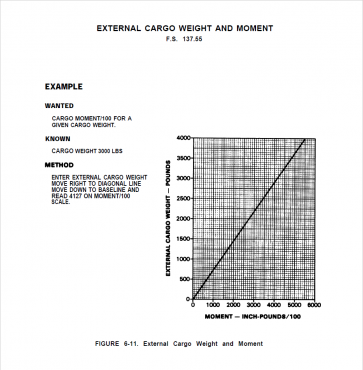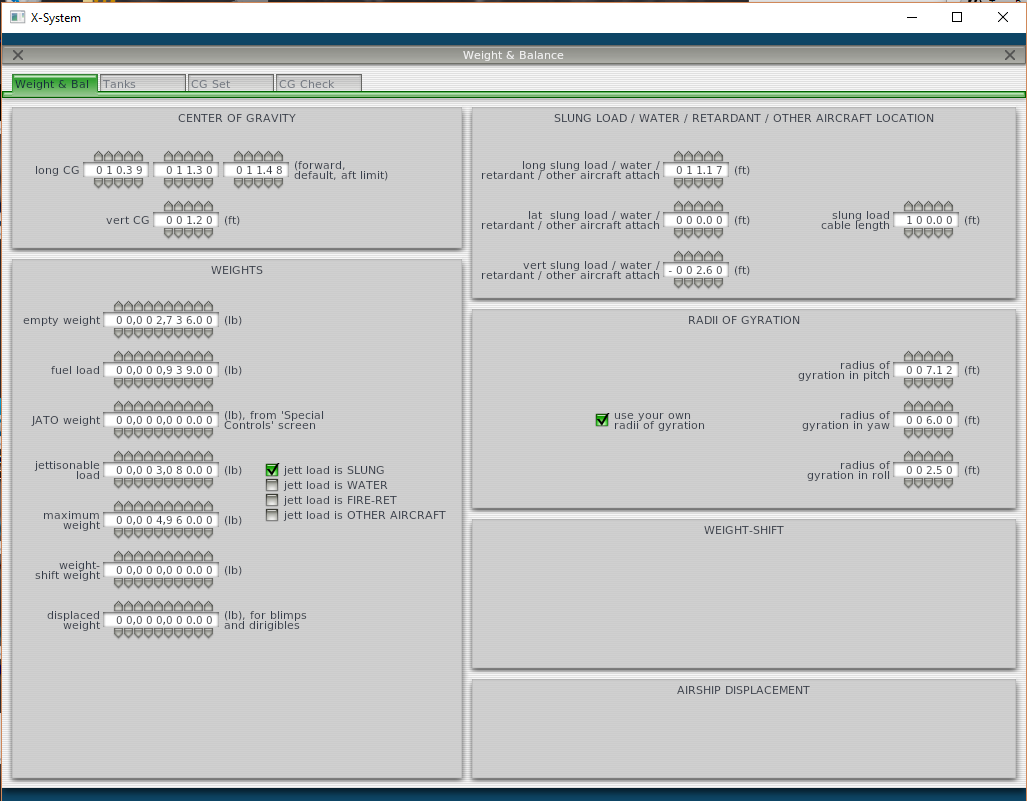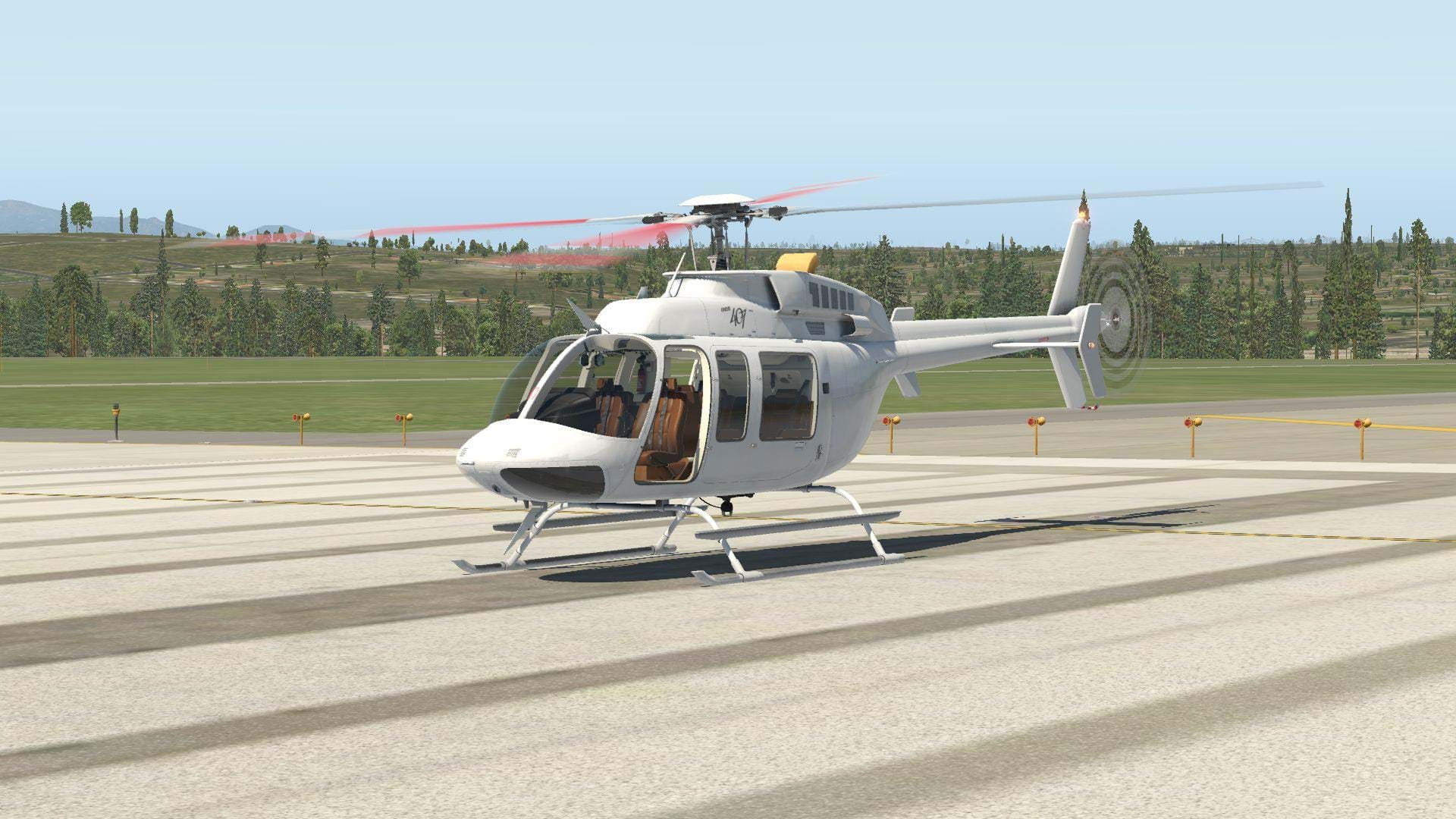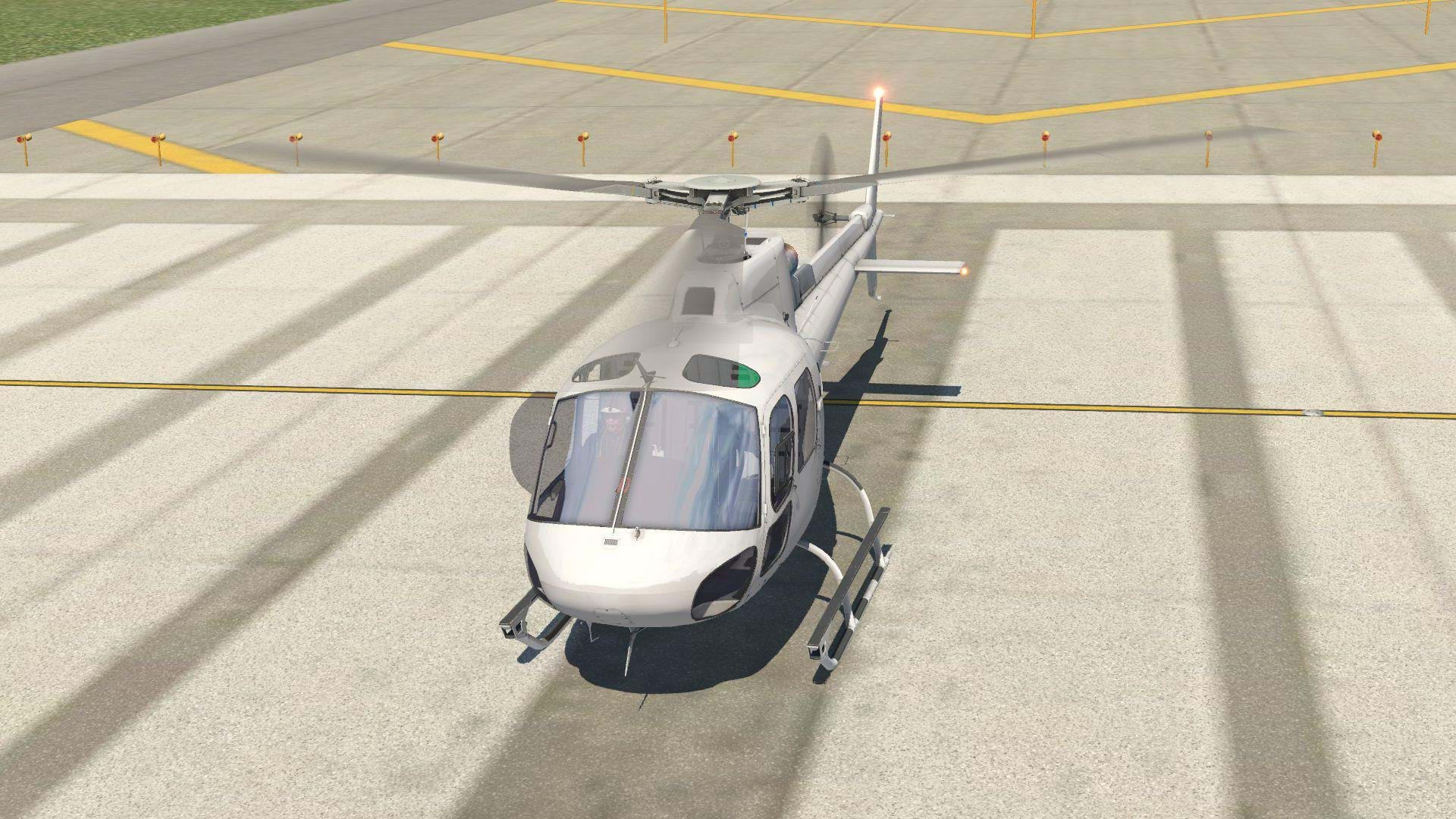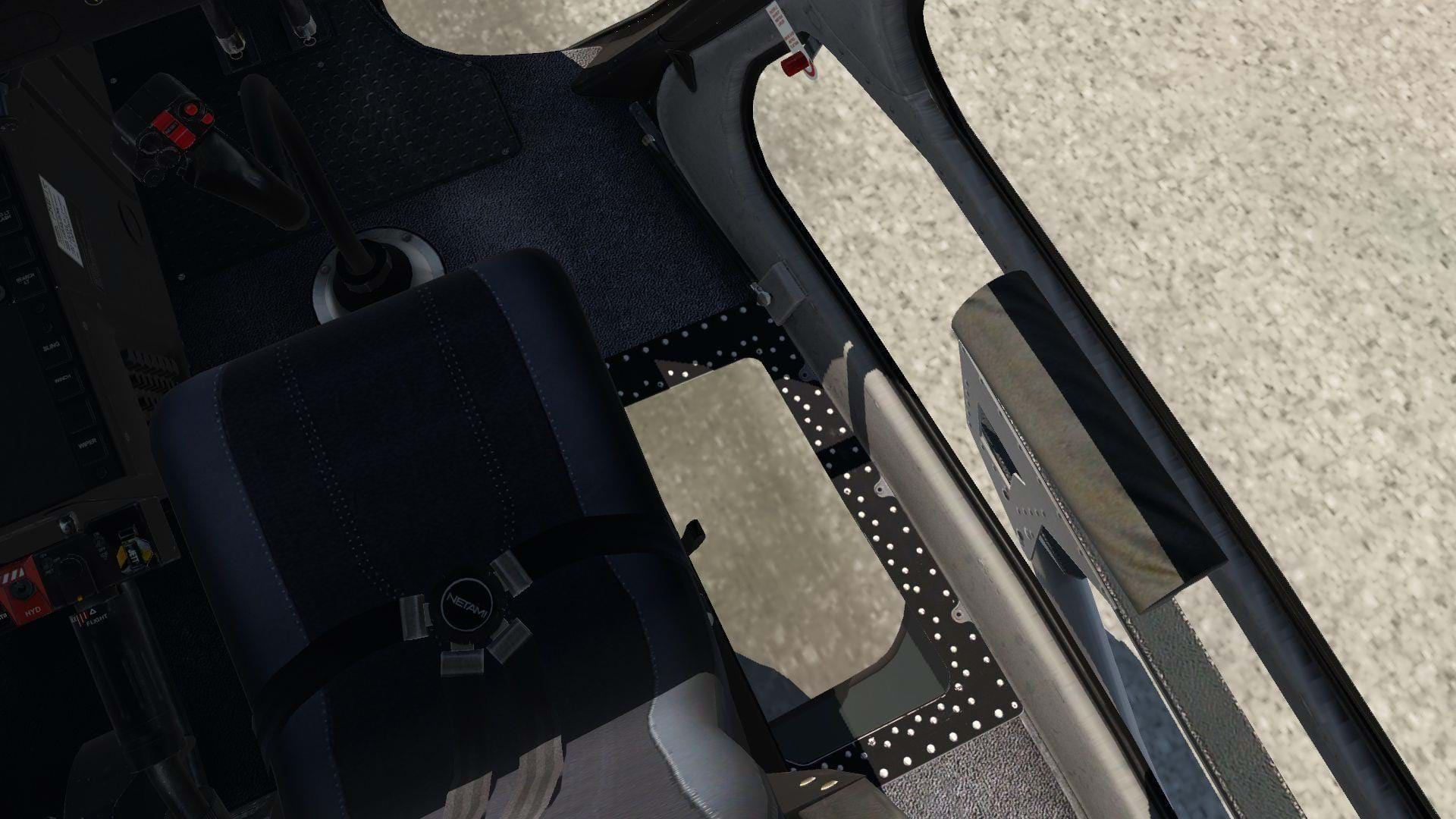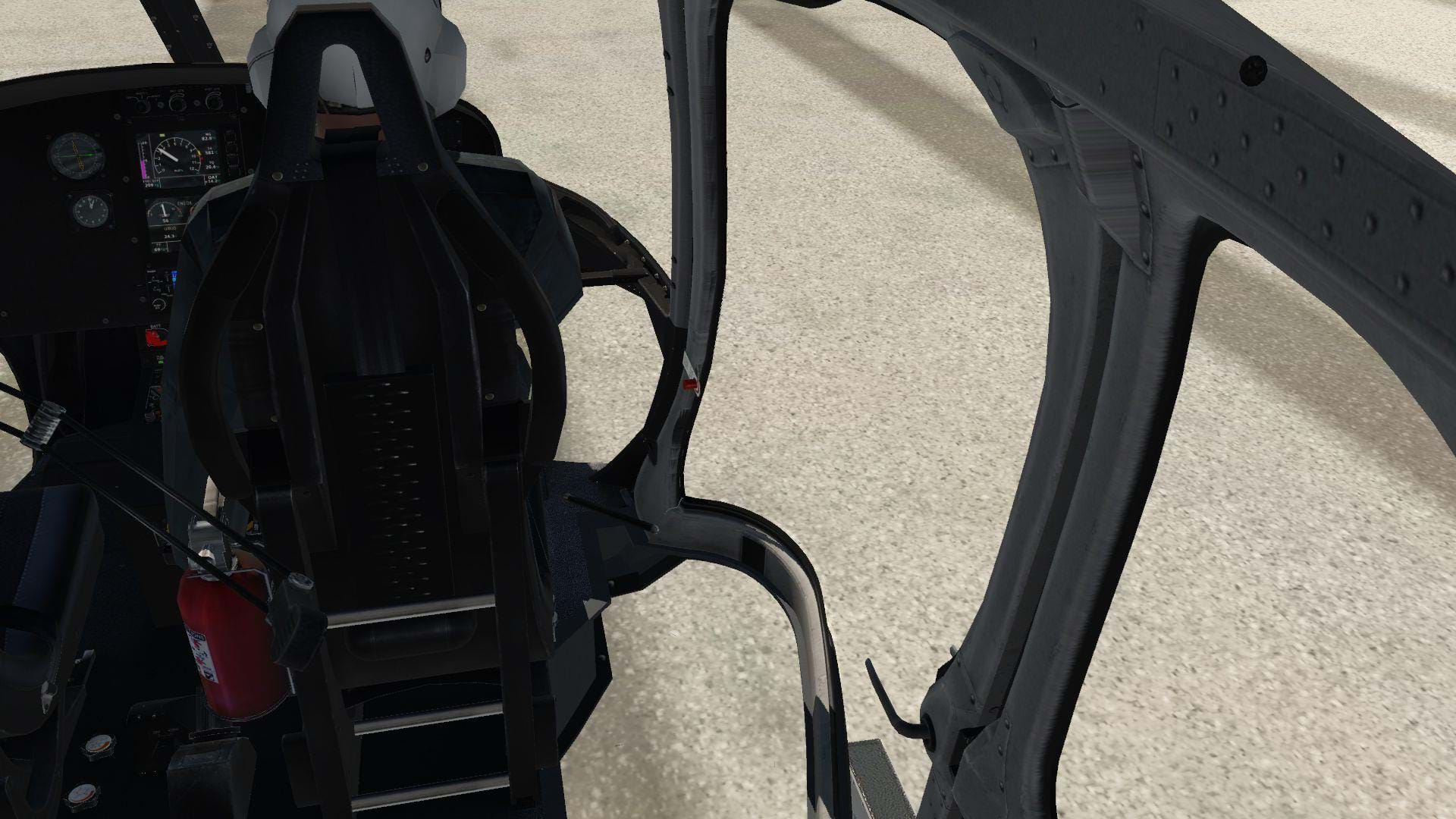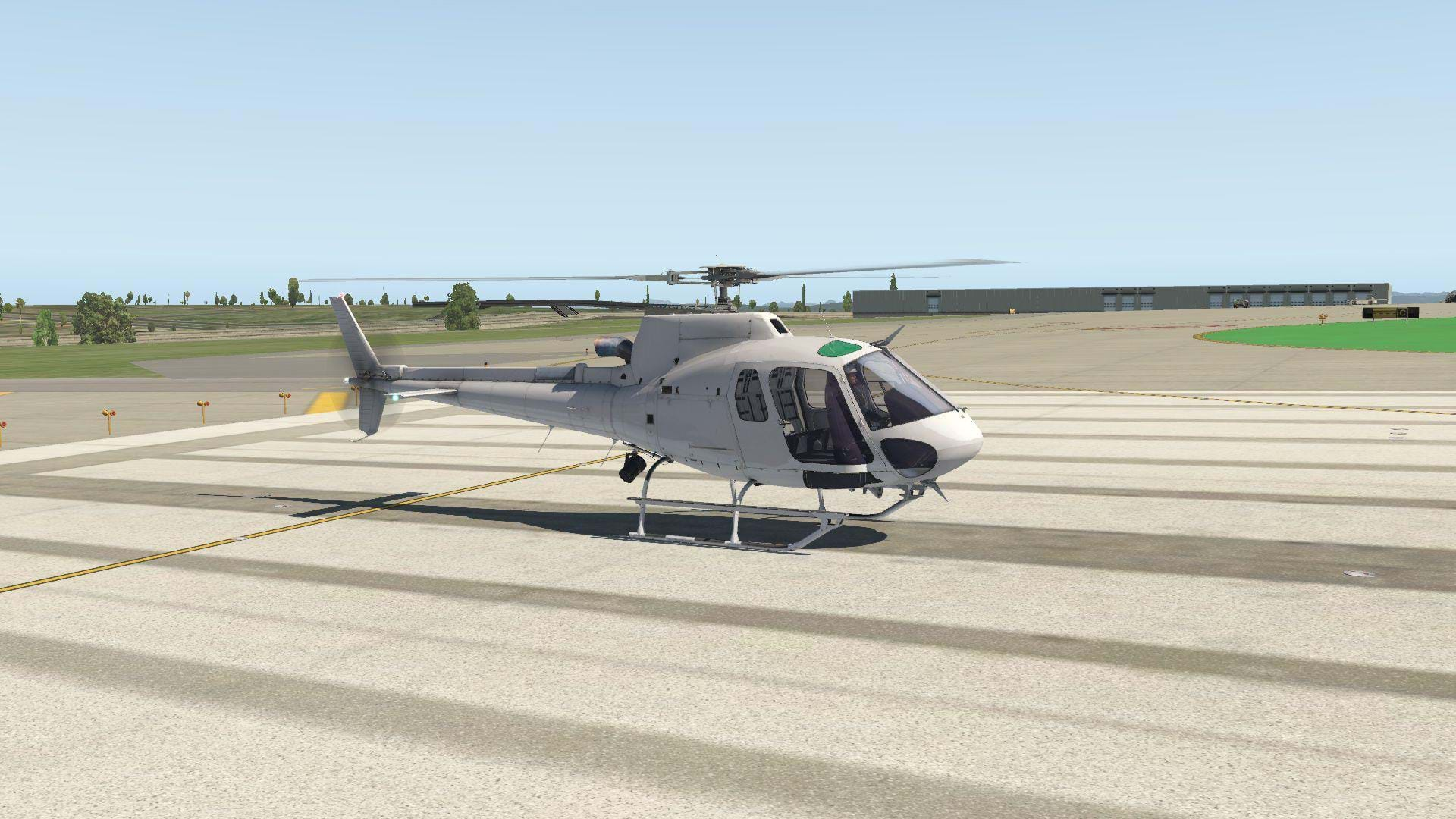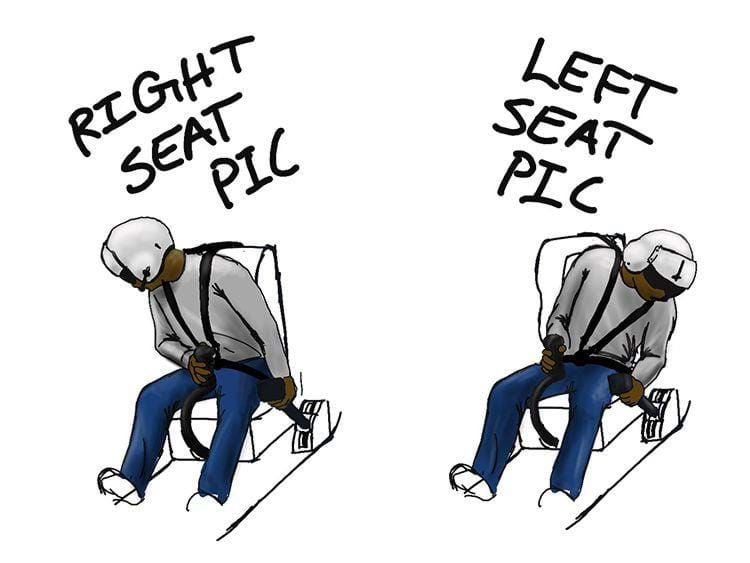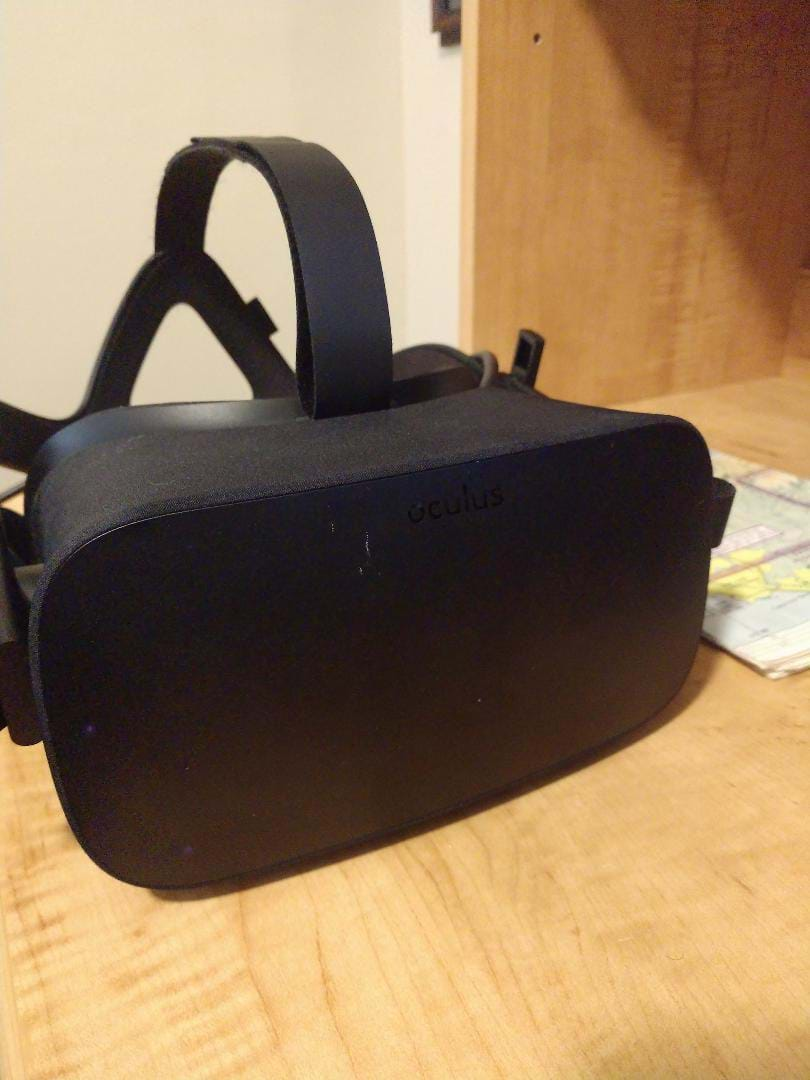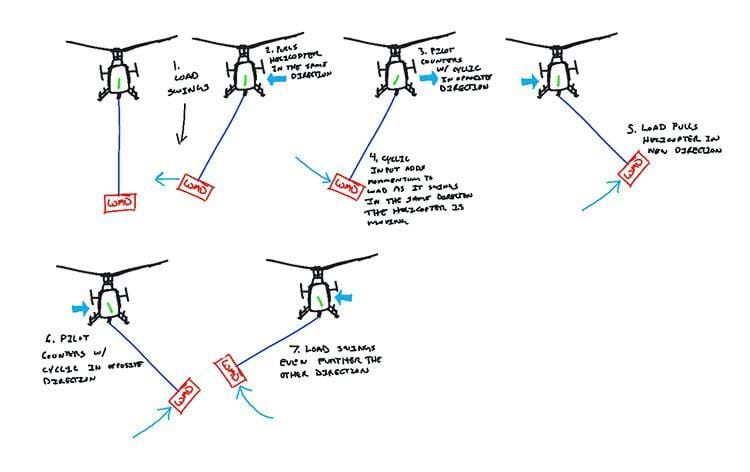In January of 2003, at a small airport in southern California flying a Schweitzer 300C, I had my first vertical reference long line training flight. I instantly fell in love with it. It was extremely fun, challenging, frustrating, and rewarding.
Sometimes all four of these emotions at the same time, somehow. Back then, I was certain this was the work I was going to do the rest of my career. But, life has a way of ignoring unrealistic youthful expectations. The good news is that since then, I’ve been extremely fortunate to be able to make my living as a helicopter pilot in a very rewarding, but entirely different type of flying.
Like some other Pilots out there, I use home flight simulation to supplement my flight training. Up until recently, IFR/IMC training was one of the biggest benefits of home flight simulation for me personally. Mostly because it is a skill set that I want to keep sharp, and IFR/IMC flight is not a big part of my current job description.
Vertical Reference long line isn’t part of my current job description at all, but it’s something I always wanted to get back into because of the great experience I had at that little southern California airport 15 years ago.
Prior to 2016, training vertical reference long line was impossible to do at home in any real meaningful way. However, since then one important tool became widely available to the average consumer, and everything changed.
What is Vertical Reference?
Vertical reference long line is a type of sling loading that you typically only see done in the private sector by civilians and sometimes in law enforcement.
Militaries around the world do what I’ll call for the sake of this article “regular” sling loading all the time. Based on the name, you can easily think vertical reference and regular sling loading are the same thing but there are many significant differences between the two.
Vertical Reference is usually done single pilot, with no one else in the aircraft to help guide the load to its intended location. On larger helicopters, you may find a second pilot in the aircraft, but his or her duties are usually restricted to watching the gauges, so the other pilot can focus on moving the load.
Perhaps the biggest and most significant difference between the two is the technique used to maintain a stable hover over the ground without the help of the horizon. Most, if not all helicopter pilots, are trained to hover by looking out in front of them. This gives them an easy and familiar set of visual cues to help determine the position of the aircraft in each axis.
This is very natural because humans usually get their visual cues for spatial orientation and balance by visually scanning their environment in the horizontal plane. This is probably why you never see a tightrope walker looking straight down as he or she walk across a wire strung 100ft above the ground.
For Vertical Reference flying, the pilot now must now get these cues in the vertical plane as the name suggests. This involves physically leaning to one side to look underneath and sometimes behind the helicopter. Ever wonder why some helicopters have large bubble windows on one or both sides of the cockpit? Those are there to enable the pilot to lean out and see the load they are carrying and the ground without having to take off the helicopter’s door.
This can be a huge advantage in very hot, cold or rainy environments.
What do I need to do it at home in a simulator?
In industry publications Vertical Reference Long Line is commonly referred to as VR (which can be confusing to flight simulation enthusiasts). It’s also known as Vertical Reference, or simply Long Line.
So, to keep it from getting confusing I’ll refer to Vertical Reference as Long Line, and Virtual Reality as VR. This vertical point of view is a completely new world for a helicopter pilot new to this type of flying, and until a few years ago, it was a world that was impossible to experience in any meaningful way using a desktop computer based flight simulator. Like I said in the beginning of this article, a tool was made available to the masses, and everything changed. That tool is Virtual Reality.
I was what you would call an “Early Adopter” of VR, purchasing my Oculus Rift in November of 2016. Right after my first session with the new head mounted display I immediately began thinking about using this for long line training.
I had tried long line training with a home use simulator a few times before. My first attempt was to simply adjust the view in the virtual cockpit to look down and over the side of the aircraft. This option was hilariously unrealistic.
Doing vertical reference by looking straight ahead at a 2D monitor wasn’t beneficial at all. I’m sure if I had practiced it that way, I would have eventually figured out how to do it, but I would be practicing a completely different skill set than what I would need to actually do vertical reference flying. My second attempt to do VR was to place a separate monitor on the floor next to my seat. I found that technique to be better than the first attempt, but still woefully inadequate for training at home.
The virtual space that VR provided a paradigm shift in home flight simulation. Sure, there are some gripes about the resolution, and some valid complaints about motion sickness, but there’s no denying that VR changed the game in home flight simulation in terms of realism and immersion, nothing else I’ve tried at home gives you the feeling of actually being in an aircraft.
The benefits of VR we the missing ingredient to vertical reference long line training at home. Now, I not only had the ability to look around my virtual cockpit, including leaning out the side, but I also had my simulated environment in 3D which helps with depth perception.
3D added a lot more to the experience than I initially thought it would. So, to sum it up, VR is essential to train this type of flying at home. Because of cost, VR can be very exclusionary, which is unfortunate, but it is essential if you want to do this type of training in any meaningful way that will transfer these skills to actual real-world flying.
What simulators can I use?
There are 3 main flight simulators available on the market for helicopters that have VR support and have some ability to do vertical reference training: Microsoft Flight Simulator X/ Lockheed Martin Prepar3D (FSX/P3D), Laminar Research X-Plane 11 (XP11), and Eagle Dynamics Digital Combat Simulator (DCS).
I’ve done long line in all three, and I’ve found that the best option is X-Plane with DCS being a close second.
FSX
FSX simply does not support a good vertical reference Long line experience, and it takes a bit of wizardry in the mission creator to set up a longline flight outside of the Sugarloaf Mountain and sling load training missions included in FSX Acceleration. And the flight modeling in FSX isn’t the best for anything helicopter related.
DCS is great for regular sling loading as it’s built into the simulator and has a very good physics for the external loads. However, none of the aircraft models available for DCS are set up very well for Vertical Reference long line.
DCS is, at its core, a military simulation, so it makes sense that no one there really considered vertical reference long line. I don’t own P3D, So I can’t speak to any potential improvements that it might offer other that native VR support.
DCS
The UH-1H by BelSimTek was pretty good, however there are some challenges if you wish to use that model for long line.
The first being that there’s no bubble window, and no way to remove either cockpit door, so you have to stick your face through the virtual window to be able to look down at your sling load or open the door which is equally as irritating to me.
The second challenge is that you can only get a 100ft sling in DCS, which is more than enough for most people doing regular sling loading. This is probably much more than the average simulator user would need.
As of the time this is being written, the biggest disadvantage of the current build of the DCS UH-1H by BelSimTek is that their Huey’s engine is... Well... How should I put this? F*#@d up.
This was the result of well intentioned, but an ultimately flawed and poorly executed attempt to bring consequences for exceeding EGT limits. This led to a simulated engine that runs much warmer than a healthy T53-L-13 normally would. Doing any sort of heavy lifting with the current DCS Huey usually results in the load staying on the ground, or your engine exploding for what feels like no reason.
In the demonstration video below the helicopter weights about 6,400lbs including fuel, the load it’s lifting is about 2,200lbs bringing the total flight weight to 8,600lbs. This is 900lbs below the max takeoff weight. The airfield elevation is about 2500ft, and the outside air temperature was set at 20 degrees Celsius. According to Chapter 7 of the operator manual, these parameters are well within the performance capabilities of the UH-1H.
As you can see in the video, torque applications well below the mechanical limit produce EGT temperatures well above normal for those atmospheric conditions. It’s doubtful that the DCS UH-1H modeled as of this writing would pass a HIT check on its engine.
I’ve spoken with Eagle Dynamics several times as this article was being written, and I’m happy to say that they are currently testing a fix. However, due to some challenges with the code, the most likely course of action for the UH-1H model in the future is a complete re-build of the engine modeling.
Unfortunately, that will take a lot of time to complete. Hopefully, it would be worth the wait if it gives us a better modeled engine in the end.
The Mi-8 is also great for sling loading, but poor for vertical reference long line. The wide cockpit and high set windows make leaning out the side of the airframe difficult.
Plus, with a helicopter that large, a sling longer than 100 feet might be necessary to see the load beneath you which you can’t get in DCS. This is all totally forgivable because the Mi-8 wasn’t designed for this type of work.
An advantage DCS has for regular sling load operations is a simulated Crew Chief/flight engineer. It’s a voice in your headset that gives you verbal cues such as “left ten, forward five, hold position” to guide you to the load while the pilot maintains focus in front of the aircraft.
This voice (who always sounds Russian for some reason) also advises you when the load is hanging steady, or if the load begins to swing around. This is great and all, but as I mentioned earlier, most vertical reference flying is done single pilot, or with a second pilot watching the cockpit instruments.
There’s no one else in the cockpit talking you onto the load. That’s why you have your head sticking out the window!
Another advantage that DCS has over X-Plane is that the loads are persistent. What I mean by that is that the load will be visible above ground the entire time, even after it’s released. This is unlike the native X-Plane sling load support where the load and sling cable disappear after the load is released from the aircraft.
DCS also has a disappearing sling cable, but the load stays put. This makes sense to do because most military sling loads are rigged on the ground, and attached directly to the belly of the aircraft. When the load reaches the drop of sight, the load is detached from the belly of the aircraft and not the sling cable.
DCS also simulates a damage or destroyed load which is cool.
X-Plane
Like I mentioned before, I’ve found X-Plane to be the best experience for long ling training, so this is the simulator we’ll be talking about for the rest of the article.
Through X-Plane’s included Plane Maker program, you can adjust the length of the sling that you want to use for each model. There is a 3rd party plugin that will be released in the near future that will allow you to do this while X-Plane is running.
This plugin will take many of the advantages found in DCS and bring them to X-Plane. Things like persistent loads, lots of load options and adjustable cable lengths in game without the use of plane maker. Expect more news from HeliSimmer on this new plugin in the future.
X-Plane has two models that work well for long line: the DreamFoil 407, and AS350/H125. Both of these models allow you to remove the doors for an unrestricted view beneath the helicopter.
The DreamFoil S300 is also a good candidate, however I’m reserving judgment on this until the X-plane 11 version is released.
Even though it was originally created for X-Plane 10, the current DreamFoil AS350 works pretty well in X-plane 11. The 3rd party developer SwissCreations created an awesome addon pack (which is available for free) that gives you options for a bubble window and several types of floor windows, as well as the Max Pilot View Kit.
All of these options are replicas of real world modifications designed to make the AS350/H125 a better airframe for long line jobs.
So far, my favorite model to train in is the DreamFoil Bell 407. It’s stable, forgiving and has great visibility from the left seat. I look forward to the UH-1H from Nimbus Studios, and the upcoming MD500D, updated 300CBi and AS350 from DreamFoil. I predict that all of these up coming models will be great for long line training.
What else do I need to get started?
Aside from VR, which is an absolute must for Vertical Reference, it all depends on how serious you are and, unfortunately, how much money you have.
For most casual flight simulation users, there’s no real need to do long line training using real world techniques so, there’s some wiggle room if you’re just doing this for fun. I will not say that long line can’t be done without a full set of helicopter specific flight controls, but I would imagine having a hard time without my Pro-Flight Trainer Puma.
It’s certainly possible to do it with something other than helicopter specific set of controls, but it will not be the same quality of training or the same experience. That can be said about helicopter flight simulation in general, but for long line the differences are even greater when using a desktop mounted stick and throttle vs. a floor mounted cyclic, collective and pedal set up.
The difference in training is most obvious when comparing the 407 to the AS350/H125. When I learned to fly real world long line, I trained in the Schweitzer 300C, which has the PIC seat on the left hand side, which is the preferred seat for most long line operations.
This is because leaning out of the left-hand side of the aircraft is a lot easier, it keeps your left arm closer to the collective, and the position of your right arm remains relatively the same and in a more comfortable position. This is why you’ll find that there are some aftermarket kits for helicopters like the Bell 407 that enable them to be converted from right seat PIC to left seat PIC.
The Robinson Helicopter Company now has an option for a factory installed left seat PIC conversion kit for its R66 specifically for long line. When doing simulator training in the DreamFoil 407, I move my seat position over to the left for this reason.
When sitting on the right side of the aircraft, as with the AS350/H125 the feeling is completely different. Now the pilot is reaching for the collective because he or she is leaning away from it. The positioning of the right arm is also a bit different because one has to extend it a bit more to make cyclic control input.
That does not mean that right seat long line is impossible. To the contrary, the AS350/H125 is a very popular airframe for long line work, as well as the Sikorsky S-58T, which is also a right side PIC helicopter.
Getting back to my original point, if you want to train left seat or right seat long line in a meaningful way, the flight controls that you use should not be sitting on a desktop. The price of dedicated helicopter specific flight controls has come down a little over the years, and there are more options now than there have ever been but still, not everyone can afford a set.
If you are using a stick, throttle and pedals, you should find a way to have the throttle mounted to the side of your chair or next to it in a location similar to where a collective would be. Your joystick should be centered between your legs no further back than mid thigh, no further forward than your knees at a height where you can rest your forearm on your right leg.
This should somewhat replicate the positioning of the cyclic. The wrist and arm movements will be different from a floor mounted cyclic, but it’s a start. The point is, leaning outside the helicopter is one of the most important parts of making this at home training realistic. So, unless your controls are set up to allow you to do this, you’re not going to get the full experience.
You will also need to make sure that you have the proper clearance around your seat. If you are already using VR for room scale gaming, you’re already ahead of the game in this aspect, because you’ve likely already cleared your play area of obstructions. But if you’re a flight simulator only guy like me, you may have to move some things around in the room you do your simulator flying in.
Most of the time when piloting an aircraft, airplane or helicopter, real or simulated, you’re never required to stick your head and shoulders out of the door in flight, so this is something that most home simulator users may not take into consideration. Trust me, nothing breaks the immersion of virtual reality flying like smashing you head in to something you couldn’t see under your head set. I can personally attest to this, my oculus rift headset bears some scars from smacking my simulated face into an actual wall in an attempt to look down at the load swinging beneath me.
Flying Simulated Vertical Reference Long Line
I am NOT a long line expert, nor am I pretending to be one. 15 years ago, I got some fantastic training from the best in the business but haven’t done this type of flying in an actual helicopter since then.
The videos in this article are a demonstration of what CAN be done using home flight simulation, not necessarily how it should be done. My goal for this article isn’t to teach anyone how to do long line. My goal is to offer a little exposure to this unique type of flying, and to open the eyes of some of the real-world pilots who follow HeliSimmer to the possibilities and potential of home use flight simulation that you may not have been aware of.
And, perhaps, pass along a few tips that I was taught along the way. So, think of this as more informative, rather than instructional. As mentioned in the disclaimer at the top of the article, this is NOT intended to be used as flight instruction.
Set up
Set up in X-plane is pretty simple. After you’ve determined the sling cable length in Plane Maker, all you must do then is select the load you want to carry. I usually use the Helicopter objects from SwissCreations. I also like the loads that come with the X-trident Bell 412.
To select the load, use the customize aircraft tab, select the Weight and Balance option. At the bottom you’ll see the option to select a sling load and the weight of that load. If you are running Windows, a separate window will open, and you’ll find that the folder it opens is the one belonging to whatever aircraft you are using.
You won’t see this in VR, so you’ll have to remove your head set to see it on your monitor. Use your mouse to navigate to the folder where your load obj. files are, and select one. I usually create a short cut to the load folder and place it in the folders belonging to the aircraft that I use most often to save time.
You can use pretty much any obj. file you want as a load, but I’ve found the SwissCreations and X-trident loads to be the best for training. After you select the load you want to use, you’ll be brought back into the aircraft weight page. This you can see in VR.
The next step is to select the weight of the load. The Swiss Creations and X-Trident loads already have weights assigned, but you can adjust them here to almost whatever you want. I started training with a 50-pound load, and now routinely train with 1,000 pounds when flying with the Bell 407 and AS350/H125.
Performance planning is key! Make sure that the load you’re lifting isn’t outside the capability of the aircraft model that you’re using. In addition to the load weight, air temperature, fuel load and elevation all play critical roles in the lifting ability of your aircraft.
Don’t expect to hop in a light single engine helicopter with a 4,000lb load on a 103-degree day at a 5,000-foot elevation with a full tank of fuel. You’re going to have to manage you fuel load and respect the limitations of the aircraft. You should really only carry enough fuel to fly to the job site, lift and place the load, and fly home.
Some real world operators often bring fuel trucks to the job site if there are multiple lifts being done, so the aircraft doing to lift work can maintain the minimum amount of fuel for the job, then fill up to fly home.
The hover
Before attaching a 1,000lb load to the bottom of your helicopter and blasting off with a 200-foot line, you might want to practice maintaining a solid OGE hover while looking straight down with your VR headset.
This typically isn’t how you’ll begin in real world training, but we’re talking simulators here, and we have the luxury of baby steps. You will probably notice that things may get out of hand rather quickly and you’ll have to look up to a normal head position to stabilize the aircraft.
Practicing an OGE hover looking straight down will do a few things. One, it will help train your brain on the basics of detecting drift while looking vertically downward and two, it will allow you to see if this is going to cause you to suffer from motion sickness, which is a very real possibility when doing this in VR. If you do get motion sickness, STOP! Take a break, and do something else. If you continue to get motion sickness, perhaps this time of flying isn’t for you. And that’s ok.
If you are using this to prepare for or supplement real world training, this stage of your training is one of the few times I would recommend increasing the stability of a flight simulator model.
Assuming you already know how to hover, increasing the stability will help you focus on figuring out what the helicopter is actually doing, instead of constantly reacting to what it’s doing. This is a new environment and you’ll need to figure out what corrections to make. If you’re already good at hovering looking out in front of you, then there is less chance of a negative habit transfer when temporarily increasing stability.
The goal for this initial part of the training is to teach your brain new reference points, your cyclic hand should already know what to do. Now, that does not mean that you should increase the stability to the point of removing all realism from the model, absolutely not! I would say increase pitch and roll stability to about 25% to start with, then gradually bring it back down to zero, as you get better at it hovering looking down.
The first lift
First thing is first. This type of flying is extremely challenging, and it’s not for everyone. So, if you find that your first attempt in the simulator is less than spectacular, there is nothing wrong with your simulator, it’s just that this type of flying requires a lot more skill and patience than usual.
Even more so in a simulator because you are using nothing but visual references as well as a restricted field of view. So, in short, it’s not that this is unrealistic or impossible, you probably just suck at it. Which isn’t out of the ordinary.
Even if you are a seasoned real-world pilot, you’re likely going to have trouble with long line the first few tries in a simulator. It’s nothing short of having to learn to fly again. I started up on simulated Long Line training about two months before writing this article, and I still have sessions where the load gets completely out of hand.
So, say your hover is solid, and yet, the load suddenly decides to do whatever it wants and begins to swing about as if it’s afraid to be directly underneath an operating helicopter. This might describe your first attempt at flying long line in a simulator. It’s important to remember, that now you are flying for two.
You used to be able to make large, sharp and sudden corrections when you were hovering on your own. While it was fine before, with a load attached these control inputs translate to imparting motion on the load and it dangles beneath you. Most loads that a helicopter will sling are typically inert, meaning the only aerodynamic properties they have are weight and drag. They don’t want to fly on their own and have no desire to move unless acted on by some outside force.
One of the keys to preventing load oscillations are flying very smoothly and avoiding abrupt control inputs. A lot of pilots think they’re smooth, and they might be, but they may not be long line smooth.
One of the most dangerous things about an oscillating load is that it is often made worse by a novice or over confident pilots’ attempts to correct them. When a load begins to swing a terrible cycle can begin. When the load reaches the apex of is swing, the weight of the load will pull the aircraft in the same direction the load was going.
The pilots brain sees this, and the pilots body feels this as the Aircraft drifting in an undesired direction, so naturally, the pilots right arm applies cyclic in the opposite direction to stop the drift. This reaction can be done almost sub-consciously or by habit.
But, instead of stabilizing the load, what the pilot has just done is “pull” the load in the opposite direction adding to its momentum as it naturally starts to swing the other way. The load swings all the way to the other side, which again pulls the helicopter in that direction. The pilot reacts and pulls the load in the opposite direction exacerbating the oscillation.
Oscillation control
This takes practice, but the concept is actually very simple. First, the goal is to keep the load from oscillating in the first place! For beginners (myself included) that’s much easier said than done.
There is one key point of advice that has stuck with me ever since I started my journey with vertical reference long line flying 15 years ago.
FLY THE HELICOPTER, NOT THE LOAD!
This one sentence has been the key to many successful careers in vertical reference flying. My mentor and instructor repeated it over and over again during my long line training, and the training of many others.
So, what does it mean? Well, most oscillations begin by the pilot, usually a novice or overconfident one (such as myself) getting fixated, and staring at the load beneath the helicopter, almost as if you’re trying to fly the load remotely from the cockpit.
This can lead to a loss of situational awareness that can result in over controlling and induced motion on the load hanging beneath you. You still need to be focused beneath the aircraft when positioning and placing the load, but staring at the object dangling beneath you, as tempting as it may be is, a recipe for trouble.
But despite your best efforts, which is often in my case, the load gets to swinging anyway, and you’ve got to get it to stop. There are lots of techniques to do this, but all of them essentially have the same goal. That goal is to get the center of mass of the load, back directly beneath the helicopter.
A swinging load may seem like it has a mind of its own, but in reality, it’s just an inanimate object bound to the laws of physics. So, it’s up to the pilot to move the helicopter in a way that nullifies the loads acceleration and returns the loads center of mass to a nice spot directly beneath the helicopter where it can just sit and enjoy the ride to the drop off point.
[Oscillation control video]
Maintaining a steady ground speed is also important. You’ll want to avoid any sort of stop and go type flying. If you make your acceleration and deceleration smooth and consistent, the load beneath you will be happy to dangle beneath the aircraft and follow you around.
Placement
Placing the load you are carrying is one of the most difficult parts of long line flying (for me at least). A big part of that is what I mentioned earlier. This is the point in the flight where you are mostly likely going to be drawn into staring at the load.
This could cause oscillations at the worst possible time. If you’re accustomed to doing large flare type decelerations when you slow down your aircraft, you’ll find that the load beneath you may not be so impressed with your fancy flying style and will continue on in the direction that you were both once flying. This will lead to a large fore/aft swinging motion. There are ways to do a large flare and keep the loads center of mass beneath the helicopter, but that is far more advanced than what we’re talking about in this article.
Patience, patience. Smooth, smooth
My mentor calmly repeated this to me over and over when I was learning to fly long line years ago, and it still holds true today in this simulated setting. This type of work requires a smooth right hand, and an almost Zen-like patience.
Another phrase common in the military “slow is smooth, smooth is fast” also applies here. Don’t rush! You are more likely to make a mistake that will just cause more work for yourself.
Is this type of flying for me?
Flying Vertical Reference long line is a niche in the real-world helicopter industry. It’s not something that all helicopter pilots are trained to do. It would make sense that it would be somewhat of a niche in the already small home flight simulation community, but for different reasons.
Real world long line training can be expensive, especially if you don’t get the hang of it right away. This is one of the most exciting things about the potential for training this at home, and VR makes it possible. But, VR headsets aren’t cheap. Neither are the computers powerful enough to run them and most flight simulators smoothly. Helicopter specific flight controls are another additional cost that would be a hurdle for anyone looking to get the full experience at home.
If you are a casual flight simulator user who does this as a hobby, you might try this a few times, decide it’s not for you and then move on to something else, which is totally fine. You should spend your free time doing what every type of simulated flying you enjoy. If you are a more serious flight simulator enthusiast, you may really enjoy the challenge of this new type of flying, or you may decide that just regular sling load operations are your thing and have a great time doing that.
For those real-world pilots who use flight simulation to supplement or enhance your real world training, virtual reality and a good set of flight controls have the potential be a great way to reduce your training costs of getting into Vertical Reference Long line flying.
However, if you are serious about pursuing this skill in the real world, I will offer this once bit of advice: find a flight school that offers this type of training (a real one obviously) and get an hour or two of actual long line experience before supplementing on a simulator.
You can potentially teach yourself bad habits on your own without any guidance that could actually increase your training time and costs in the long run. I strongly believe this is a great supplement for real training but want to emphasize that this is in no way a replacement for actual flight training under the guidance of an experienced certified flight instructor.
HAVE FUN!

